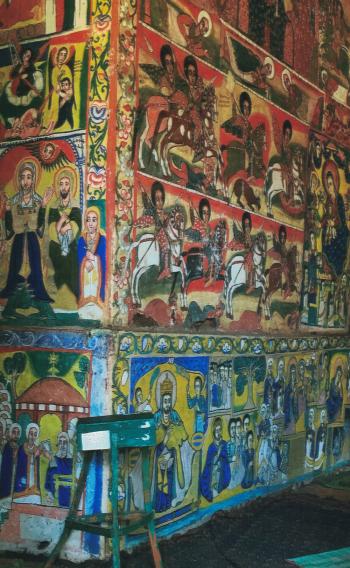Exploring northern Ethiopia on a private tour
This article appears on page 34 of the May 2019 issue.
I had been to Africa a number of times, but I had never been to Ethiopia. The only African country not to be colonized, it has its own language, writing system, music, dancing style, dress, food and way of telling time. All of that fascinated me.
Heading out
My 22-day trip from March to April 2018 began with seven days in the northern part of the country, which is what I will cover in this article. With my guide, Tefera Alemu of Tefera Tours (Addis Ababa; tefera.tours), and his driver, Geta, I set out to see the country.
I was traveling solo, so it was just the three of us for the entire time. We occasionally were joined by a museum, village, park or church guide.
The cost of the entire 3-week trip, excluding airfare from Seattle, was $4,800, all inclusive. (The price per person would be less if there were two people to share the cost of hotels.)
All the hotels were clean and in good locations, with breakfast included, and all the meals were traditional, which I had requested. The only additional costs were tips at the end of the trip.
I arrived at the airport in Addis Ababa early in the day, so there was time for sightseeing. This included a trip to the National Museum to see “Lucy” and to Holy Trinity Cathedral, where former emperor Haile Selassie is buried.
I had lunch with Tefera’s parents and experienced my first Ethiopian coffee ceremony, which began with the roasting of the beans and ended with three small cups of freshly brewed coffee.
In the evening, I enjoyed a traditional performance that was a wonderful introduction to the music and dance of Ethiopia.
Countryside and coffee
I took an early-morning flight to Bahir Dar the next day. After a requested walk through the market, we had a lakeside lunch of tilapia fish followed by a boat trip on Tana Lake to an island to see the circular churches that are covered inside with murals of Bible stories.
I learned how to recognize wild coffee plants during our walk around the island. Our guide, Wasah, took me to his mud-brick family home on the island. Neighbors arrived, and we were all served homemade tej (honey wine).
On Day 3 we headed farther north. Our first stop was a roadside coffee café for “real,” not hotel-perked, coffee. Sitting on plastic chairs, we sipped coffee from characteristic little cups with no handles.
After getting back on the road, we stopped so I could try my hand at tilling a field with an ox-pulled plow. It was more difficult than it looked!
Continuing our day of mostly driving through the interesting countryside, we arrived at Gondar, our destination for the night, where we went out for tella (barley beer).
The next morning we headed to Simien Mountains National Park, where we were required to have a park guide and a farmer guide with a rifle along with us. We had a picnic overlooking the canyon, then took a short hike, with a stop in a field among the Gelada baboons, found only in the high mountains of Ethiopia. The baboons mingled and ate grass while I sat among them watching.
We drove back to Gondar for the night.
Sightseeing, shopping and sheep
The next day began with a tour of Fasil Ghebbi, billed as Gondar’s most important attraction. This compound encompassing castles and palaces was once the home of royalty.
A guide there is important in order to understand the significance of the place, but, for me, it was too much information.
After lunch at a charming restaurant called Four Sisters, we went to Fasilides’ Bath, a religious pool that is filled only for Timket, the ceremonial celebration of Christ’s baptism that takes place each January.
Before the day ended, we headed to the Gondar market. Tefera, Geta and their friend who runs a dress kiosk helped me choose a white, embroidered traditional dress to wear on Easter, when I would be back in Addis.
On Day 6 we drove to Lalibela to see the rock-hewn churches. The road was occupied with herds of cows or sheep heading to or from grazing lands. We would slowly drive through the herds or the young boys would herd their animals to the side of the road. Much of our travel that day was on dirt roads that were under construction.
Our dinner stop was Ben Abeba, a Scottish/Ethiopian-owned restaurant, where we watched the sunset — quite a unique place.
The week winds down
We spent most of the next day climbing down, in, out and around the southern cluster of five churches in Lalibela.
There is so much to see there. I would suggest focusing on a few churches instead of trying to see them all.
Sitting on the rocks and listening to the church service was an important part of the experience. Services last for several hours and are conducted outside the churches, as they are quite small inside.
On my last day in the north, we had a last look at two more churches in the northwest section in Lalibela and took a walk to Bete Giyorgis, the Church of St. George, which is a “must see.” A shared minibus then took us to the airport for a flight back to Addis Ababa, from where we would continue our travels to the southern part of the country.
It was such fun to be with Tefera and Geta, two great guys with a marvelous sense of humor and adventure. I loved every minute of travel with them and learned a lot about this country that is like no other.



